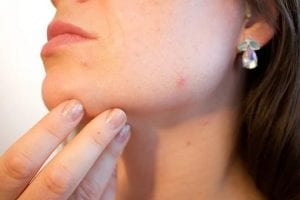Written by Harold Oster, MD. Results suggest that topical application of a product containing Silybum marianum fruit extract is beneficial in treating adolescents and young adults with mild to moderate acne.
 Acne vulgaris affects over 80% of adolescents and young adults. Acne negatively affects quality of life and is associated with depression, other mood disorders, hospitalization, and suicide1. Extract from the fruit of Silybum marianum, known as milk thistle, has anti-inflammatory and antioxidant properties due to its main component, silymarin2. In a small study, topically applied Silybum marianum fruit extract (SMFE) showed benefit in treating mild to moderate acne3.
Acne vulgaris affects over 80% of adolescents and young adults. Acne negatively affects quality of life and is associated with depression, other mood disorders, hospitalization, and suicide1. Extract from the fruit of Silybum marianum, known as milk thistle, has anti-inflammatory and antioxidant properties due to its main component, silymarin2. In a small study, topically applied Silybum marianum fruit extract (SMFE) showed benefit in treating mild to moderate acne3.
Foteini Bageorgou et al. studied the tolerance and effectiveness of a topical SMFE-containing product when used by adolescents and young adults. Dermatologists from 21 international geographic regions recruited patients with mild to moderate acne according to the Global Evaluation of Acne (GEA) scale4. The GEA scale is a six-point grading scale where zero is no visible acne lesions, 1 is minimal lesions, 2 is mild, with a few lesions on less than half the face, and 3 is moderate, with numerous lesions on more than half the face. Based on defined inclusion criteria, 4,230 participants were entered into the study. All patients were instructed to apply the SMFE product twice daily for 8-12 weeks. They were divided into three groups: those who had not used other medications for acne (initial therapy), those who were actively using anti-acne medications (associated therapy), and those who had previously completed a course of anti-acne therapy (maintenance therapy). At the end of the study, the dermatologists re-evaluated the patients’ level of acne on the GEA scale. Quality of life was self-assessed by the five-question Cardiff Acne Disability Index (CADI)5 at the beginning and end of the study. Patients described any adverse effects, and the dermatologists rated tolerance based on dermatologic signs on a four-point scale from very good to poor. The dermatologists and the participants assessed the effectiveness of the intervention using a subjective four-point scale from very effective to ineffective. The use of the product was considered a success if the effectiveness was rated as very effective or effective and the tolerance was very good or good.
The authors noted the following:
- At baseline, 16.6% of participants had GEA grade 1, 48.3% had grade 2, and 35.1% had grade 3.
- 47% of participants were on initial therapy, 48% were on associated therapy with first-line acne medications, and 5% were in the maintenance therapy group.
- Tolerance to SMFE extract was good or very good in 95% of all participants and 93% in the GEA grade 3 group.
- Dermatologists reported 165 adverse effects. The proportion of patients showing signs of adverse effects was lower in the maintenance group (2%) than in the initial (4%) or associated group (4%).
- Dermatologists reported a reduction of GEA grade of 0.8 overall (a 36% reduction) with improvement in 69% of participants. GEA grade reduction was 0.7 in the initial therapy group, 0.9 in the associated therapy group, and 0.8 in the maintenance group.
- Overall effectiveness was rated as effective or very effective for 80% of total participants, in 83% of the patients with a baseline GEA grade of 2, 79% with a grade of 3, and 77% of those with grade 1.
- Measured using the CADI index, quality of life of the participants improved over the course of the study.
- The use of the study product was considered a clinical success in 84% of the participants, with similar results in the three treatment groups.
Results of the study suggest that a skincare product containing Silybum marianum fruit extract is well tolerated and effective in treating mild to moderate acne. Limitations of the study include the absence of a placebo group and the lack of compliance monitoring.
Source: Bageorgou, Foteini, Li Li, Christopher Beausillon, Aline Stennevin, Ariadna Ortiz‐Brugués, and Jean Hilaire Saurat. “Tolerability and effectiveness of a dermocosmetic product containing Silybum marianum fruit extract in adolescents and young adults with acne‐prone skin: An international, phase IV, longitudinal study.” Journal of Cosmetic Dermatology (2023).
© 2023 Pierre Fabre Dermo-Cosmetique. Journal of Cosmetic Dermatology published by Wiley Periodicals LLC.
Click here to read the full text study.
Posted September 5, 2023.
Harold Oster, MD graduated from medical school in Miami, Florida in 1992 and moved to Minnesota in 2004. After more than 25 years of practicing Internal Medicine, he recently retired. Dr. Oster is especially interested in nutrition, weight management, and disease prevention. Visit his website at haroldoster.com.
References:
- Habeshian KA, Cohen BA. Current Issues in the Treatment of Acne Vulgaris. Pediatrics. May 2020;145(Suppl 2):S225-s230. doi:10.1542/peds.2019-2056L
- Post-White J, Ladas EJ, Kelly KM. Advances in the use of milk thistle (Silybum marianum). Integr Cancer Ther. Jun 2007;6(2):104-9. doi:10.1177/1534735407301632
- Saurat JH, Reygagne P, Josse G, et al. Long-Term Use of Silybum marianum fruit extract Contributes to Homeostasis in Acne-Prone Skin-A 12-Month Follow-Up International “Real Life” Cohort Study. J Pers Med. Dec 31 2022;13(1)doi:10.3390/jpm13010096
- Dréno B, Poli F, Pawin H, et al. Development and evaluation of a Global Acne Severity Scale (GEA Scale) suitable for France and Europe. J Eur Acad Dermatol Venereol. Jan 2011;25(1):43-8. doi:10.1111/j.1468-3083.2010.03685.x
- Abdelrazik YT, Ali FM, Salek MS, Finlay AY. Clinical experience and psychometric properties of the Cardiff Acne Disability Index (CADI). Br J Dermatol. Oct 2021;185(4):711-724. doi:10.1111/bjd.20391
